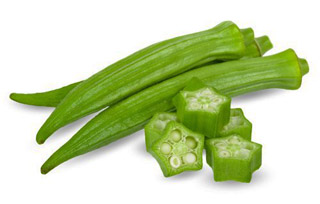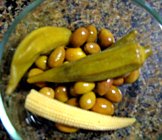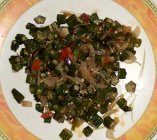Okra Nutrition facts
Okra, also known as "lady's finger," or "bamia pod" is one of the favorite nutritious vegetables of North-East African origin. The pods usually are gathered while they are green, tender, and at the immature stage.
Botanically, okra is a perennial flowering plant in the Malvaceae (mallows) family and named scientifically Abelmoschus esculentus.
It is cultivated throughout the tropical and warm temperate regions around the world for its phytonutrients-rich pods. It grows best in well-drained and manure-rich soil.
 |
| Okra pods. |
The okra plant bears numerous dark green pods measuring about 5-15 cm in length. It takes about 45-60 days to get ready-to-harvest fruits. Internally, the pods feature small, round, mucilaginous white color seeds arranged in vertical rows. The pods are handpicked while just short of reaching maturity and eaten as a vegetable.
7 Amazing Health Benefits of Okra
The okra pods are among the very low-calorie vegetables. They provide just 30 calories per 100 g besides containing no saturated fats or cholesterol. Nonetheless, they are rich sources of dietary fiber, minerals, and vitamins, often recommended by nutritionists in cholesterol-controlling and weight-reduction programs.
The pods are one of the rich sources of mucilage substance that helps in smooth peristalsis of digested food through the gut and eases constipation condition.
The pods compose healthy amounts of vitamin-A, and flavonoid anti-oxidants such as beta-carotene, xanthin, and lutein. It is one of the vegetables with the highest levels of these antioxidants. Vitamin A is essential for maintaining healthy mucosa and skin. Consumption of natural vegetables and fruits rich in flavonoids helps to protect from lung and oral cavity cancers.
Fresh pods are the good source of folates, provide about 22% of RDA per 100 g. Consumption of foods rich in folates, especially during the pre-conception period helps decrease the incidence of neural tube defects in the newborn.
Okra pods are also an excellent source of antioxidant vitamin, vitamin-C, providing about 36% of daily recommended levels. Research suggests that the consumption of foods rich in vitamin C helps the human body develop immunity to combat infectious agents, reduce episodes of cold and cough, and protect it from harmful free radicals.
They are rich in the B-complex group of vitamins like niacin, vitamin B-6 (pyridoxine), thiamin, and pantothenic acid. The pods also contain good amounts of vitamin K . Vitamin K is a co-factor for blood clotting enzymes and is required for bone health.
The pods are also a good source of many essential minerals such as iron, calcium, manganese, and magnesium.
| Principle | Nutrient Value | Percent of RDA |
|---|---|---|
| Energy | 33 Kcal | 1.5% |
| Carbohydrates | 7.03 g | 5.4% |
| Protein | 2.0 g | 4% |
| Total Fat | 0.1 g | 0.5% |
| Cholesterol | 0 mg | 0% |
| Dietary Fiber | 9% | 3.2 g |
| Vitamins | ||
| Folates | 88 µg | 22% |
| Niacin | 1.000 mg | 6% |
| Pantothenic acid | 0.245 mg | 5% |
| Pyridoxine | 0.215 mg | 16.5% |
| Riboflavin | 0.060 mg | 4.5% |
| Thiamin | 0.200 mg | 17% |
| Vitamin C | 21.1 mg | 36% |
| Vitamin A | 375 IU | 12.5% |
| Vitamin E | 0.36 mg | 2.5% |
| Vitamin K | 53 µg | 44% |
| Electrolytes | ||
| Sodium | 8 mg | 0.5% |
| Potassium | 303 mg | 6% |
| Minerals | ||
| Calcium | 81 mg | 8% |
| Copper | 0.094 mg | 10% |
| Iron | 0.80 mg | 10% |
| Magnesium | 57 mg | 14% |
| Manganese | 0.990 mg | 43% |
| Phosphorus | 63 mg | 9% |
| Selenium | 0.7 µg | 1% |
| Zinc | 0.60 mg | 5.5% |
| Phyto-nutrients | ||
| Carotene-ß | 225 µg | -- |
| Crypto-xanthin-ß | 0 µg | -- |
| Lutein-zeaxanthin | 516 µg | -- |
Selection and storage
Fresh, immature okra pods can be readily available in the stores year-round. The pods feature an attractively rich green color and have a neutral flavor. In the markets, look for crispy, immature pods.
Avoid those with over-mature, sunken, discolored, spots, cuts, and mushy.
Once at home, eat them while they are fresh to obtain the full benefits of vitamins and antioxidants. They may also stay well for 1-2 days when placed in the refrigerator.
Preparation and serving methods
Some hybrid varieties of okra may have been subjected to insecticide/pesticide sprays. Therefore, wash the pods thoroughly in the cold water in order to remove dirt, soil, and any residual insecticides.
Trim the top stem end using a paring knife. Although not required, some may prefer trimming tip ends as well. Then, cut/slice the pod as desired in the cooking.
Here are some serving tips:

|
 |
| Pickled gumbo pods with baby corn, and beans. Photo courtesy: wharman |
Okra pod stir fry with onion, tomato, and green chilies. |
Okra pods are one of the widely used vegetables in tropical countries. Chopped, or sliced, they can be stewed or fried (fritters) under low heat oil to soften their mucilaginous texture. They then can be mixed with other vegetables, rice, or meat.
In the Caribbean islands, okra is cooked and enjoyed in soup, often with fish.
Fresh okra pods often feature in the "Louisiana state cuisine", used as a thickener in seafood gumbos. This mucilaginous vegetable is usually cooked first, and other ingredients are added once the desired consistency is reached
The pods can be pickled and preserved like in other vegetables.
Tender okra leaves may be cooked in a similar manner as the greens of beets or dandelions. The leaves can also be eaten raw in salads.
Thick stew of lamb or beef and okra (bamiya) is a popular dish in Egypt and other Middle Eastern regions.
Safety profile
Insecticide sprays are sometimes applied over okra crops. Therefore, it is recommended to wash them in cold running water before use.
Okra is a safe and nutritious vegetable for most people and well-tolerated when consumed as part of a balanced diet. (Medical Disclaimer).
≻≻-Back to Vegetables from Okra. Visit here for an impressive list of vegetables with complete illustrations of their nutrition facts and health benefits.
≻≻-Back to Home page.
Further Resources:
Vegetable directory page- University of Illinois extension.